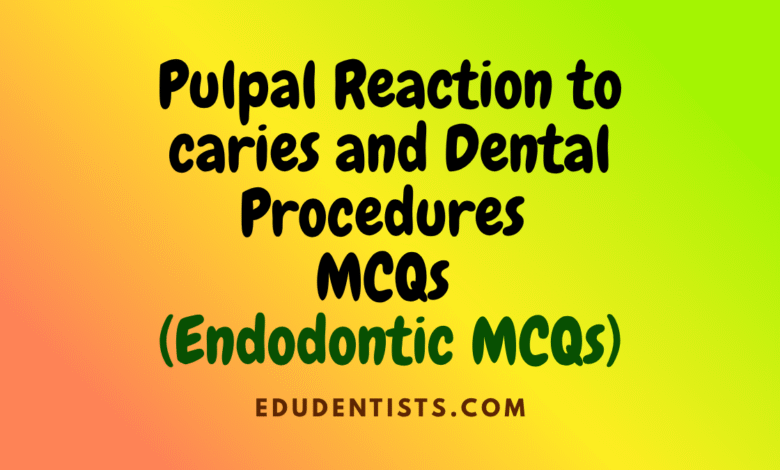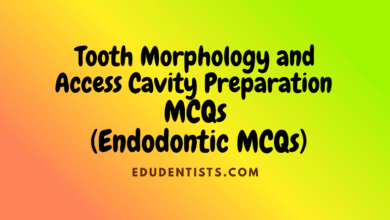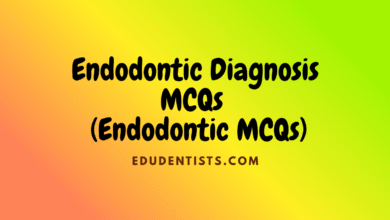Pulpal Reaction to caries and Dental Procedures (Endodontic MCQs)
Pulpal Reaction to caries and Dental Procedures (Endodontic MCQs)

Pulpal Reaction to caries and Dental Procedures _ Endodontic MCQs
Pulpal Reaction to caries and Dental Procedures _ Endodontic MCQs
1. The most common defensive response in the dentin deep to caries is which of the following:
A) Increased permeability
B) Alteration of collagen
C) Dissolut ion of peritubular dentin
D) Dentinal sclerosis
2. Tertiary dentinogenesis in the pulp in response to caries may be the result of stimulation of odontoblasts by:
A) Byproducts of caries bacteria
B) Salivary proteins diffusing through tubules
C) Fractions of dentin matrix proteins diffusing across dentin
D) Pulpal inflammatory cell cytokines
3. A periodontal ligament injection of 2 lidocaine with 1:100,000 epinephrine causes which of the following:
A) Pulpal circulation stops for about 60 minutes.
B) Pulpal circulation remains the same.
C) Pulpal circulation increases markedly.
D) Pulpal circulation decreases slightly.
4. The highest incidence of pulp necrosis is associated with which of the following:
A) Class V preparations on the root surface
B) Inlay preparations
C) Partial veneer restorations
D) Full crown preparations
5. Which of the following is a disadvantage of acid etching dentin with regard to effects on the pulp
A) Dentinal tubules are opened, increasing permeability.
B) Acid penetrates to the pulp and kills large numbers of cells.
C) Acid penetrates to the pulp and damages the vessels.
D) Acid softens the dentin and increases microleakage at the restoration-dentin interface.
6. With chronic inflammation, pulpal dendritic cells
A) Increase in density
B) Suppress the inflammatory response
C) Convert the inflammation from chronic to acute
D) Phagocytose bacteria as they enter the pulp
7. The long-term outcome of pulp capping of carious exposures:
A) Depends primarily on the capping material used
B) Depends on whether bacteria have invaded the pulp
C) Is affected by the severity of symptoms
D) Is unfavorable
8. Which of the following is a reaction that tends to protect the pulp from injury caused by dentinal caries:
A) A predictable stimulation of sensory nerves, resulting in pain
B) A decrease in the permeability of the dentin
C) An increase in the number of odontoblasts under the tubules affected by the caries
D) Buffering (i.e., neutralization) of bacterial toxins by ground substance
E) A decrease in pulpal metabolism
9. Hypersensitivity is best relieved or controlled by which of the following:
A) Opening the tubules to permit release of intrapulpal pressure
B) Root planing to remove hypersensitive surface layers
C) Applying antiinflammatory agents to exposed dentin
D) Blocking exposed tubules on the dentin surface
10. Deeper cavity preparations have more potential for pulpal damage because of which of the following:
A) Tubular diameter and density increase, therefore permeability increases.
B) There is more vibration to pulp cells.
C) Odontoblastic processes are more likely to be severed.
D) a and c
E) b and c
F) a and b
11. Which of the following is the best way to prevent pulp damage during cavity preparation:
A) Retain the smear layer.
B) Use sharp burs with a brush stroke
C) Use adequate air coolant
D) Use adequate water coolant
12. The major reason Class II restorations with composite damage the pulp is:
A) Composite chemicals supply substrate to bacteria.
B) The setting reaction produces a damaging amount of heat.
C) Toxic chemicals are released from the composite and diffuse into the pulp.
D) Polymerization shrinkage distorts cusps and opens gaps.
13. The pulp has been damaged and is inflamed because of deep caries and cavity preparation. What material, when placed on the floor of the cavity, aids resolution of the pulpal inflammation:
A) Calcium hydroxide
B) Zinc oxideeugenol
C) Steroid formulations
D) None; no material promotes healing
14. What is the history of symptoms of irreversible pulpitis that results in necrosis:
A) Seldo m symptomatic
B) Usually marked by moderate symptoms
C) Usually marked by an absence of severe symptoms
D) Usually marked by severe symptoms
16. The early inflammatory cell infiltrate response of the pulp to caries involves primarily which of the following:
A) Neutrophils
B) Macrophages
C) Neutrophils, plasma cells, and lymphocyte
D) Macrophages and lymphocytes
E) Lymphocytes, plasma cells, and macrophages
17. Hypersensitivity of the pulp after restoration placement indicates which of the following:
A) Acute inflammation in the pulp
B) Chronic inflammation in the pulp
C) Microleakage at the restoration-tooth interface
D) Stimulation of sensory nerves by hydrodynamics
18. With severe pulp damage from excessive heat during cavity preparation, the patient response usually is:
A) Extreme sensitivity to heat
B) Spontaneous pain
C) Pain on mastication
D) No symptoms
19. The evidence on the use of lasers to treat hypersensitivity indicates that:
A) They are very effective.
B) They are effective only in severe cases.
C) Only the Nd:YAG laser is effective.
D) Other techniques are recommended.
20. Which of the following statements is correct about the effect of orthognathic surgery on the pulp:
A) The canal space sometimes is obliterated.
B) Pulpal blood flow is seldom affected.
C) Pulpal blood flow is reduced and never recovers.
D) Inflammation or necrosis of the pulp is rare.





